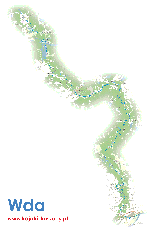The beautiful lowland-forest and meandering Wda among forests is a very picturesque and attractive landscape trail. It has numerous bays, and its sandy-rocky bottom is overgrown with seaweed. Also called Czarna Woda, it begins its course on the Charzykowska Plain, flowing out of Lake Krążno. In large meanders and arcs it leads through the Tuchola Forest. Below Lake Wdzydze, the Wda Canal branches off. Below Tleń, the Wda flows into the Świecie Upland and flows into the Vistula in Świecie, in the Fordon Valley, at an altitude of about 23 m above sea level.
In the upper section the river can be capricious, and at the beginning of its course it is almost suitable for rafting. Although at times troublesome, at other times it becomes a feisty river with a fast current. In this area it flows through numerous lakes, and in addition there are over 350 smaller or larger lakes not far from it. In its middle course the Wda becomes a fast, wild river with numerous rapids, cutting through the Tuchola Forest. Peace and quiet reign here, because it is a great area.
In its lower course it passes the dam lakes in front of the power plants, and behind them it becomes fast and untamed. Between the two twin rivers: the Brda and the Wda, stretches the Tuchola Forest, the second largest forest complex in Poland, located between Chojnice and Tuchola in the south and Kościerzyna and Starogard Gdański in the north. There are numerous ribbon lakes here with a total area of 120 thousand ha. There are preserved refuges for rare bird species. e.g.
On the slopes of river valleys, mainly the Wda, very valuable and rare multi-species deciduous forests with a diverse flora of lichens have developed, and in the valley bottoms there are alluvial forests (forests with rich undergrowth and ground cover) and alder forests (swamp forests with a predominance of black alder). A peculiarity is the occurrence of wild service tree in the "Brzęki" reserve named after Zygmunt Czubiński in Szczerków. Among the rare and protected plants in the Wda Landscape Park are, among others: clubmoss, flattened clubmoss and juniper clubmoss, sundews, broadleaf and spotted orchids, lesser butterfly-orchid, broadleaf helleborine, common twayblade, wild ginger and bearberry. Fauna peculiarities include cranes, goldeneyes, goosanders, marsh harriers, ruffs, kingfishers, brown trouts, European adders, spotted salamanders, tree frogs and great crested newts. Covering this less developed water artery of the Tuchola Forest and Kociewie by kayak will not pose any problems even for less skilled water sportsmen, although Lake Wdzydzkie can be a dangerous obstacle in bad weather.


